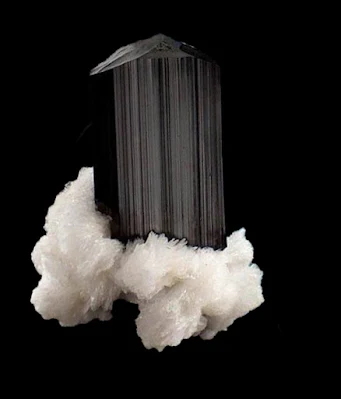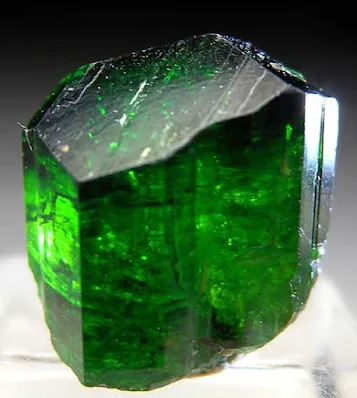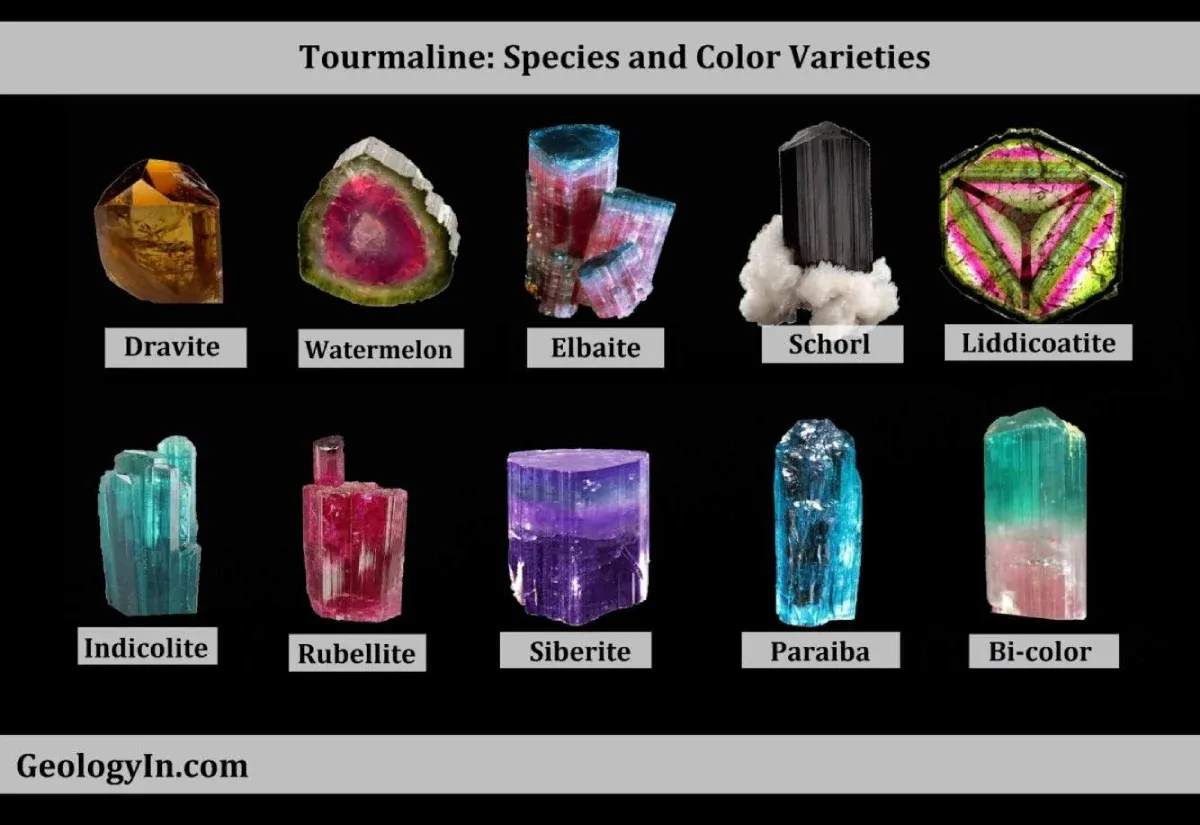Tourmaline: Colors and Types of Tourmaline
Tourmaline is one of the most colorful gemstones in the world, with a wider range of colors than any other gemstone. It can be found in every color of the rainbow, as well as colorless and black.
Tourmaline is a crystalline boron silicate mineral compounded with elements such as aluminium, iron, magnesium, sodium, lithium, or potassium. It is hard and durable and very well suited for jewelry.
Tourmaline is classified as a semi-precious stone and the gemstone comes in a wide variety of colors. It is a pyroelectric mineral, meaning that when warmed, it attracts dust and other lightweight particles.
Though Elbaite occurs in all color forms, the term Elbaite in the gemstone trade is sometimes used to describe the green form of Tourmaline. The other color forms of Elbaite have their own variety names on the gem market. Traditional Tourmaline gemstone variety names include Rubellite, the red or pink variety, Indicolite, the blue variety, and Watermelon Tourmaline, a multicolored Tourmaline of green and red.
Tourmaline colors
The color of tourmaline is caused by the presence of different trace elements in the mineral. The most common color-causing elements are iron, manganese, chromium, copper, and vanadium.- Iron: Iron can produce green, blue, and black tourmaline.
- Manganese: Manganese can produce pink, red, and yellow tourmaline.
- Chromium: Chromium can produce intense green tourmaline.
- Copper: Copper can produce intense blue tourmaline, such as Paraiba tourmaline.
- Vanadium: Vanadium can produce yellow and brown tourmaline.
Bi-colored and multicolored crystals are common, reflecting variations of fluid chemistry during crystallization. Crystals may be green at one end and pink at the other, or green on the outside and pink inside; this type is called watermelon tourmaline. Some forms of tourmaline are dichroic, in that they change color when viewed from different directions.
All colored Tourmaline gems display pleochroism, meaning their color changes when viewed at different angles. In some Tourmaline gems, this effect is hardly noticeable, while in others it is strongly apparent. Gemstone cutters must take this into account when cutting a Tourmaline, so that the finished gem brings out its best color.
The most expensive and valuable form of Tourmaline is the rare neon-blue form known by the trade name Paraiba Tourmaline. Paraiba Tourmaline was first discovered in a gem pegmatite in the Brazilian state of Paraiba in 1989.
Tourmaline is found in granite and granite pegmatites and in metamorphic rocks such as schist and marble. Schorl and lithium-rich tourmalines are usually found in granite and granite pegmatite. Magnesium-rich tourmalines, dravites, are generally restricted to schists and marble.
Tourmaline Types
Schorl - Black Tourmaline
 |
| Schorl and Albite from Afghanistan.
Photo: Coisas de Tere |
Schorl is the brownish-black to black tourmaline. Schorl is the most abundant tourmaline variety. Schorl may account for 95% or more of all tourmaline in nature. Opaque black schorl and yellow tsilaisite are idiochromatic tourmaline species that have high magnetic susceptibilities due to high concentrations of iron and manganese respectively. Schorl is exclusively black and, unlike other Tourmaline forms, is never transparent or even translucent. Schorl is the most common form of Tourmaline. It Usually as elongated prismatic crystals that are heavily striated. Also as short, stubby, prismatic crystals.
Elbaite Tourmaline
 |
| Elbaite tourmaline, cluster of four intergrown "blue-cap" crystals, from Tourmaline Queen Mine, California. |
Elbaite is the most well-known and valuable form of Tourmaline. Most of the multicolored Tourmalines and almost all of the Tourmaline gemstones are of the Elbaite variety. Elbaite is allochromatic, meaning trace amounts of impurities can tint crystals, and it can be strongly pleochroic. Every color of the rainbow may be represented by elbaite, some exhibiting multicolor zonation. Microscopic acicular inclusions in some elbaite crystals show the Cat's eye effect in polished cabochons.
Liddicoatite Tourmaline
 |
| Liddicoatite Tourmaline On display at The Kristallmuseum in Riedenburg, Germany • Photo Credit : Dusted77 |
Liddicoatite is a fascinating member of the tourmaline group. It's a calcium-rich lithium tourmaline, known for its unique color zoning and vibrant hues.
Liddicoatite was not recognized as a separate Tourmaline species until 1977. Prior to that time, it was thought to be Elbaite. Liddicoatite Color: Typically boasts vibrant multi-colored zones, featuring shades of pink, green, blue, and yellow. The most prized specimens display a distinct triangular color pattern, nicknamed the "Mercedes" symbol, This is due to changes in the solution during crystal growth. Liddicoatite named after Richard T. Liddicoat, the "Father of Modern Gemology."
Significantly rarer than elbaite, liddicoatite is found in limited quantities mainly in Madagascar and other regions like Sri Lanka and Afghanistan.
Dravite Tourmaline
 |
| Dravite from Mwajanga, near Komolo, Tanzania Photo: Marin Mineral |
Dravite, also called brown tourmaline, is the sodium magnesium rich tourmaline endmember. Dravite ranges in color from pale brown and yellow to deep brown and even blue. Its transparency varies, with some stones being translucent or even transparent, offering stunning visual appeal. Compared to its relatives like schorl (black) and elbaite (rainbow of colors), dravite is rarer, adding to its value and collector's interest. Dravite, named after the Drava River in Austria.
Other Tourmaline varieties and species
There are many, mainly color, varieties of these species.
- Achroite - Colorless tourmaline. Achroite is the rarest type of tourmaline, and it is often used in industrial applications.
- Rubellite - Rubellite is the most valuable tourmaline variety, and is prized for its intense red color. (color due to iron and manganese)
- Indicolite - Blue or greenish-blue tourmaline. Indicolite is another popular tourmaline variety for jewelry, and it can be found in a range of shades from light blue to deep teal. (color due to iron)
- Verdelite - Green tourmaline. Verdelite is a more common variety of green tourmaline than chrome tourmaline, and it can be found in a range of shades from light green to deep forest green. (color due to iron and titanium)
- Siberite - Violet tourmaline from Siberia. Siberite tourmaline is often found in large crystals, and it is known for its deep purple color.
- Watermelon Tourmaline - a pink core with green edges
- Bi-color Tourmaline that displays two distinct colors, such as green and pink, or blue and yellow
- Multicolor tourmaline: Tourmaline that displays three or more distinct colors
- Paraiba - Paraíba tourmaline is a rare and valuable variety of tourmaline that is known for its intense blue-green color. (color due to copper and manganese)
Tourmaline Photos
 |
| Smoky Quartz with Lustrous Black Tourmaline from Haramosh Mts., Pakistan Credit: Daniel Virgadaula |
 |
| Tri-colors Tourmaline crystals from Paprok mine , Afghanistan Photo: Fazal Azeem |
 |
| Elbaite Tourmaline at The National Museum of Natural History, Smithsonian Institution. Photo Orbital Joe |
 |
| Siberite Tourmaline on Quartz - Ibity, Madagascar Photo SpiriferMinerals |
 |
| Chrome Dravite from from the Commander Mine Nadonjukin Tanzania. Photo: Benjamin DeCamp |
 |
| Verdelite -Tourmaline from Landani, Tanzania Photo: Marin Mineral |
It's important to note that tourmaline can exhibit pleochroism, meaning it may display different colors when viewed from different angles. Additionally, the color of tourmaline can be influenced by factors such as lighting conditions and the presence of inclusions. The wide range of colors and types of tourmaline makes it a fascinating and popular gemstone in the world of jewelry.


%20(1).webp)






